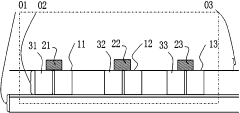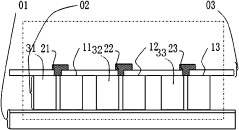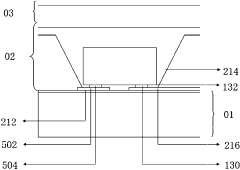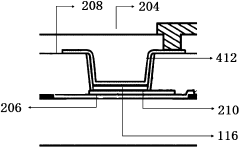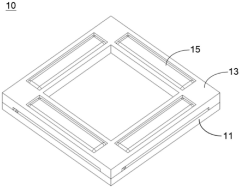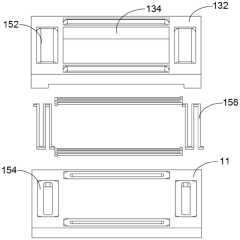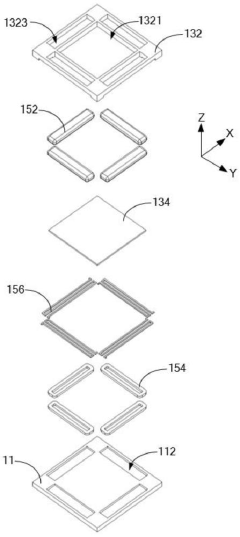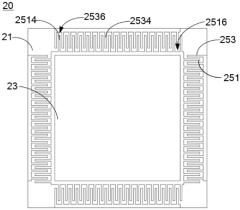How to Integrate ULED into Enterprise Solutions?
JUN 23, 20259 MIN READ
Generate Your Research Report Instantly with AI Agent
Patsnap Eureka helps you evaluate technical feasibility & market potential.
ULED Integration Background and Objectives
Ultra-Light Emitting Diode (ULED) technology has emerged as a promising innovation in the field of display and lighting solutions. This cutting-edge technology offers significant advantages over traditional LED and OLED technologies, including higher energy efficiency, improved color accuracy, and enhanced durability. As enterprises seek to modernize their infrastructure and improve operational efficiency, the integration of ULED into various business applications has become a topic of great interest and potential.
The evolution of display technologies has been marked by continuous improvements in performance, energy efficiency, and cost-effectiveness. ULED represents the latest milestone in this journey, building upon the strengths of its predecessors while addressing their limitations. The primary objective of integrating ULED into enterprise solutions is to leverage its unique characteristics to enhance various aspects of business operations, from digital signage and interactive displays to advanced lighting systems and smart office environments.
One of the key drivers behind the push for ULED integration is the growing emphasis on sustainability and energy conservation in the corporate world. ULED's superior energy efficiency aligns perfectly with these goals, offering businesses the opportunity to reduce their carbon footprint while simultaneously cutting operational costs. Additionally, the technology's ability to produce more vibrant and accurate colors opens up new possibilities for high-quality visual communications and immersive user experiences.
The integration of ULED into enterprise solutions also aims to address the increasing demand for flexible and adaptable workspace technologies. As businesses embrace hybrid work models and agile office designs, there is a growing need for display and lighting solutions that can be easily reconfigured and customized to suit various environments and use cases. ULED's versatility and potential for integration with smart building systems make it an attractive option for forward-thinking organizations looking to create more responsive and intelligent workspaces.
Furthermore, the objective of ULED integration extends beyond immediate practical applications to positioning enterprises at the forefront of technological innovation. By adopting and implementing cutting-edge display and lighting technologies, businesses can demonstrate their commitment to innovation and gain a competitive edge in their respective industries. This early adoption can also provide valuable insights and experiences that may shape the future development and application of ULED technology across various sectors.
As we explore the integration of ULED into enterprise solutions, it is crucial to consider the broader technological landscape and the potential synergies with other emerging technologies such as Internet of Things (IoT), artificial intelligence, and advanced data analytics. The successful integration of ULED may serve as a catalyst for more comprehensive digital transformation initiatives, enabling businesses to create more connected, efficient, and intelligent operational environments.
The evolution of display technologies has been marked by continuous improvements in performance, energy efficiency, and cost-effectiveness. ULED represents the latest milestone in this journey, building upon the strengths of its predecessors while addressing their limitations. The primary objective of integrating ULED into enterprise solutions is to leverage its unique characteristics to enhance various aspects of business operations, from digital signage and interactive displays to advanced lighting systems and smart office environments.
One of the key drivers behind the push for ULED integration is the growing emphasis on sustainability and energy conservation in the corporate world. ULED's superior energy efficiency aligns perfectly with these goals, offering businesses the opportunity to reduce their carbon footprint while simultaneously cutting operational costs. Additionally, the technology's ability to produce more vibrant and accurate colors opens up new possibilities for high-quality visual communications and immersive user experiences.
The integration of ULED into enterprise solutions also aims to address the increasing demand for flexible and adaptable workspace technologies. As businesses embrace hybrid work models and agile office designs, there is a growing need for display and lighting solutions that can be easily reconfigured and customized to suit various environments and use cases. ULED's versatility and potential for integration with smart building systems make it an attractive option for forward-thinking organizations looking to create more responsive and intelligent workspaces.
Furthermore, the objective of ULED integration extends beyond immediate practical applications to positioning enterprises at the forefront of technological innovation. By adopting and implementing cutting-edge display and lighting technologies, businesses can demonstrate their commitment to innovation and gain a competitive edge in their respective industries. This early adoption can also provide valuable insights and experiences that may shape the future development and application of ULED technology across various sectors.
As we explore the integration of ULED into enterprise solutions, it is crucial to consider the broader technological landscape and the potential synergies with other emerging technologies such as Internet of Things (IoT), artificial intelligence, and advanced data analytics. The successful integration of ULED may serve as a catalyst for more comprehensive digital transformation initiatives, enabling businesses to create more connected, efficient, and intelligent operational environments.
Enterprise Demand for ULED Solutions
The integration of Ultra-Light Emitting Diode (ULED) technology into enterprise solutions has become a significant focus for businesses seeking to enhance their operational efficiency and technological capabilities. As enterprises increasingly prioritize digital transformation and sustainability, the demand for ULED solutions has grown substantially across various sectors.
In the manufacturing industry, ULED integration is being sought after for its potential to improve production line visibility and quality control processes. The high-resolution displays and energy efficiency of ULED technology allow for more precise monitoring of assembly lines and real-time data visualization, leading to increased productivity and reduced errors. This demand is particularly strong in automotive and electronics manufacturing, where precision and quality are paramount.
The retail sector has shown a keen interest in ULED solutions for enhancing in-store experiences and digital signage. Retailers are looking to leverage the superior color accuracy and brightness of ULED displays to create more engaging and immersive shopping environments. This includes interactive product showcases, dynamic pricing displays, and large-format advertising screens that can operate efficiently for extended periods.
In the healthcare industry, there is a growing demand for ULED technology in medical imaging and diagnostic equipment. The high contrast ratios and wide color gamut offered by ULED displays can significantly improve the accuracy of image interpretation in radiology and surgical planning. Hospitals and clinics are also exploring ULED integration in patient information systems and telemedicine platforms to enhance communication and data presentation.
The financial services sector is another area where ULED integration is gaining traction. Banks and trading firms are investigating the use of ULED displays in trading floors and data centers to provide clearer, more energy-efficient visualization of market data and analytics. The reduced power consumption of ULED technology aligns well with the industry's push towards greener operations and cost reduction.
Corporate offices and conference facilities are also driving demand for ULED solutions. The need for high-quality, large-format displays for presentations, video conferencing, and collaborative workspaces has increased, especially with the rise of hybrid work models. ULED's ability to deliver crisp, vibrant images even in well-lit environments makes it an attractive option for these applications.
The transportation sector, including airports, train stations, and smart city initiatives, is exploring ULED integration for information displays and advertising. The durability and longevity of ULED technology, combined with its energy efficiency, make it well-suited for 24/7 operation in public spaces.
As enterprises continue to prioritize digital transformation, energy efficiency, and enhanced user experiences, the demand for ULED solutions is expected to grow further. The technology's potential to reduce operational costs while improving visual performance aligns well with the long-term strategic goals of many organizations across diverse industries.
In the manufacturing industry, ULED integration is being sought after for its potential to improve production line visibility and quality control processes. The high-resolution displays and energy efficiency of ULED technology allow for more precise monitoring of assembly lines and real-time data visualization, leading to increased productivity and reduced errors. This demand is particularly strong in automotive and electronics manufacturing, where precision and quality are paramount.
The retail sector has shown a keen interest in ULED solutions for enhancing in-store experiences and digital signage. Retailers are looking to leverage the superior color accuracy and brightness of ULED displays to create more engaging and immersive shopping environments. This includes interactive product showcases, dynamic pricing displays, and large-format advertising screens that can operate efficiently for extended periods.
In the healthcare industry, there is a growing demand for ULED technology in medical imaging and diagnostic equipment. The high contrast ratios and wide color gamut offered by ULED displays can significantly improve the accuracy of image interpretation in radiology and surgical planning. Hospitals and clinics are also exploring ULED integration in patient information systems and telemedicine platforms to enhance communication and data presentation.
The financial services sector is another area where ULED integration is gaining traction. Banks and trading firms are investigating the use of ULED displays in trading floors and data centers to provide clearer, more energy-efficient visualization of market data and analytics. The reduced power consumption of ULED technology aligns well with the industry's push towards greener operations and cost reduction.
Corporate offices and conference facilities are also driving demand for ULED solutions. The need for high-quality, large-format displays for presentations, video conferencing, and collaborative workspaces has increased, especially with the rise of hybrid work models. ULED's ability to deliver crisp, vibrant images even in well-lit environments makes it an attractive option for these applications.
The transportation sector, including airports, train stations, and smart city initiatives, is exploring ULED integration for information displays and advertising. The durability and longevity of ULED technology, combined with its energy efficiency, make it well-suited for 24/7 operation in public spaces.
As enterprises continue to prioritize digital transformation, energy efficiency, and enhanced user experiences, the demand for ULED solutions is expected to grow further. The technology's potential to reduce operational costs while improving visual performance aligns well with the long-term strategic goals of many organizations across diverse industries.
ULED Technology Status and Challenges
Ultra-Light Emitting Diode (ULED) technology has made significant strides in recent years, offering promising potential for enterprise solutions. The current status of ULED technology is characterized by its high efficiency, low power consumption, and superior color rendering capabilities. These attributes make it an attractive option for various applications within enterprise environments, particularly in areas such as display technology, lighting systems, and communication devices.
Despite its advancements, ULED technology faces several challenges in its integration into enterprise solutions. One of the primary obstacles is the high production cost associated with ULED manufacturing. The intricate processes and specialized materials required for ULED production contribute to elevated expenses, potentially limiting widespread adoption in cost-sensitive enterprise environments.
Another significant challenge lies in the scalability of ULED technology. While ULED displays have shown impressive performance in smaller form factors, scaling up to larger enterprise-grade displays while maintaining uniform brightness and color accuracy remains a technical hurdle. This limitation may impact the technology's applicability in scenarios requiring expansive display solutions, such as large-scale digital signage or immersive presentation environments.
Heat management presents an additional challenge for ULED integration. Although ULEDs are more energy-efficient than traditional LED technologies, they still generate heat during operation. In enterprise settings where continuous operation is often required, effective thermal management solutions must be developed to ensure longevity and maintain optimal performance of ULED-based systems.
The integration of ULED technology with existing enterprise infrastructure and systems poses another challenge. Compatibility issues with current hardware and software ecosystems may arise, necessitating the development of new interfaces and control systems. This integration complexity could potentially slow down the adoption process in enterprise environments that rely on established technological frameworks.
Durability and lifespan considerations also play a crucial role in the enterprise adoption of ULED technology. While ULEDs offer improved longevity compared to conventional LEDs, further advancements are needed to meet the rigorous demands of enterprise applications, where extended operational lifetimes and minimal maintenance requirements are essential.
From a geographical perspective, ULED technology development is primarily concentrated in East Asian countries, particularly Japan, South Korea, and China. This concentration of expertise and manufacturing capabilities may impact global supply chains and technology transfer, potentially affecting the widespread integration of ULED solutions in enterprises across different regions.
Despite its advancements, ULED technology faces several challenges in its integration into enterprise solutions. One of the primary obstacles is the high production cost associated with ULED manufacturing. The intricate processes and specialized materials required for ULED production contribute to elevated expenses, potentially limiting widespread adoption in cost-sensitive enterprise environments.
Another significant challenge lies in the scalability of ULED technology. While ULED displays have shown impressive performance in smaller form factors, scaling up to larger enterprise-grade displays while maintaining uniform brightness and color accuracy remains a technical hurdle. This limitation may impact the technology's applicability in scenarios requiring expansive display solutions, such as large-scale digital signage or immersive presentation environments.
Heat management presents an additional challenge for ULED integration. Although ULEDs are more energy-efficient than traditional LED technologies, they still generate heat during operation. In enterprise settings where continuous operation is often required, effective thermal management solutions must be developed to ensure longevity and maintain optimal performance of ULED-based systems.
The integration of ULED technology with existing enterprise infrastructure and systems poses another challenge. Compatibility issues with current hardware and software ecosystems may arise, necessitating the development of new interfaces and control systems. This integration complexity could potentially slow down the adoption process in enterprise environments that rely on established technological frameworks.
Durability and lifespan considerations also play a crucial role in the enterprise adoption of ULED technology. While ULEDs offer improved longevity compared to conventional LEDs, further advancements are needed to meet the rigorous demands of enterprise applications, where extended operational lifetimes and minimal maintenance requirements are essential.
From a geographical perspective, ULED technology development is primarily concentrated in East Asian countries, particularly Japan, South Korea, and China. This concentration of expertise and manufacturing capabilities may impact global supply chains and technology transfer, potentially affecting the widespread integration of ULED solutions in enterprises across different regions.
Current ULED Integration Approaches
01 ULED display panel structure
ULED (Ultra Light Emitting Diode) display panels incorporate advanced structures to enhance performance and efficiency. These structures may include specialized pixel arrangements, improved light-emitting layers, and optimized electrode configurations. The design aims to achieve better color reproduction, higher brightness, and increased energy efficiency compared to traditional LED displays.- ULED display panel structure: ULED (Ultra Light Emitting Diode) display panels incorporate advanced structures to enhance performance and efficiency. These structures may include specialized pixel arrangements, improved light-emitting layers, and optimized electrode configurations. The design aims to achieve higher brightness, better color accuracy, and increased energy efficiency compared to traditional LED displays.
- ULED backlight module design: ULED backlight modules are designed to provide uniform illumination for display panels. These modules may feature innovative light guide plates, reflective structures, and optical films to enhance light distribution and minimize energy loss. The design focuses on achieving high brightness and color uniformity while reducing power consumption.
- ULED driving and control systems: Advanced driving and control systems are developed for ULED displays to optimize performance and power efficiency. These systems may include specialized integrated circuits, pulse-width modulation techniques, and intelligent dimming algorithms. The goal is to achieve precise control over brightness levels, color reproduction, and power management in ULED displays.
- ULED manufacturing processes: Innovative manufacturing processes are employed to produce high-quality ULED components and displays. These processes may involve advanced deposition techniques, precise patterning methods, and novel packaging solutions. The focus is on improving yield rates, reducing production costs, and enhancing the overall quality and reliability of ULED products.
- ULED application in various display technologies: ULED technology is being applied to various display applications, including televisions, monitors, and mobile devices. These applications leverage the advantages of ULED, such as high brightness, wide color gamut, and energy efficiency. The integration of ULED technology aims to enhance visual experiences across different display formats and sizes.
02 ULED backlight module design
ULED backlight modules are designed to provide uniform illumination for display panels. These modules may feature innovative light guide plates, reflective structures, and optical films to enhance light distribution and minimize energy loss. The design focuses on achieving high brightness and color consistency while reducing power consumption.Expand Specific Solutions03 ULED driver circuit and control method
Advanced driver circuits and control methods are developed for ULED displays to optimize performance and power efficiency. These may include intelligent dimming algorithms, precise current control mechanisms, and temperature compensation techniques. The aim is to enhance display quality, extend lifespan, and reduce power consumption of ULED devices.Expand Specific Solutions04 ULED manufacturing process improvements
Innovations in ULED manufacturing processes focus on enhancing production efficiency and product quality. These may include advanced deposition techniques, improved material formulations, and novel packaging methods. The goal is to reduce production costs, increase yield rates, and improve the overall performance of ULED displays.Expand Specific Solutions05 ULED color management and image processing
Sophisticated color management and image processing techniques are developed for ULED displays to enhance visual quality. These may include advanced color calibration algorithms, dynamic contrast adjustment, and high dynamic range (HDR) processing. The aim is to deliver more accurate colors, improved contrast, and a wider color gamut for a superior viewing experience.Expand Specific Solutions
Key ULED Industry Players
The integration of ULED into enterprise solutions is in its early stages, with the market showing significant growth potential. The technology is rapidly evolving, driven by increasing demand for high-quality display solutions in various sectors. Companies like Lumileds LLC, Koninklijke Philips NV, and LG Innotek Co., Ltd. are at the forefront of ULED development, focusing on improving efficiency and performance. Other players such as SAP SE and Cisco Technology, Inc. are exploring ways to incorporate ULED into their enterprise offerings. The competitive landscape is diverse, with both established tech giants and specialized startups like eLux, Inc. and Micledi Microdisplays BV contributing to innovation. As the technology matures, we can expect increased adoption and integration across various enterprise applications.
Koninklijke Philips NV
Technical Solution: Philips has developed a ULED (Ultra Light Emitting Diode) integration solution for enterprise environments. Their approach focuses on creating modular ULED panels that can be easily integrated into existing office spaces, conference rooms, and industrial settings. The system includes a proprietary control interface that allows for seamless integration with building management systems, enabling centralized control of lighting across entire facilities. Philips' ULED solution also incorporates advanced color tuning capabilities, allowing for dynamic adjustment of light temperature and intensity to match circadian rhythms and enhance workplace productivity.
Strengths: Established brand in lighting technology, extensive experience in enterprise solutions, advanced control systems. Weaknesses: Potentially higher cost compared to traditional lighting solutions, may require specialized installation.
Shenzhen AOTO Electronics Co., Ltd.
Technical Solution: AOTO Electronics has developed a ULED-based display solution specifically tailored for enterprise environments. Their system utilizes ultra-fine pitch ULED technology to create high-resolution, large-format displays suitable for control rooms, boardrooms, and digital signage applications. The solution incorporates advanced image processing algorithms to enhance clarity and color accuracy, even in challenging lighting conditions. AOTO's enterprise ULED displays also feature a modular design, allowing for easy maintenance and scalability. The company has implemented a proprietary heat dissipation system to ensure long-term reliability and consistent performance in 24/7 operation scenarios.
Strengths: Specialized in large-format displays, advanced image processing capabilities, modular design for easy maintenance. Weaknesses: May be less suitable for general lighting applications, potentially higher initial investment compared to traditional display technologies.
Core ULED Integration Technologies
ULED/OLED integrated light emitting body for display
PatentActiveCN108039359A
Innovation
- Using ULED and OLED combined light emitters, by forming an epitaxial barrier crystal film layer and pixel points on the substrate, using micro ULED and OLED to connect in parallel respectively, controlling the combination of micro inorganic light-emitting diodes and organic light-emitting diodes, and using gallium nitride materials to improve Light efficiency, and achieve efficient electrical connection through the electrical interface matrix layer and LED controller.
ULED packaging structure and imaging device
PatentPendingCN116741909A
Innovation
- By introducing a drive reset component into the uLED packaging structure, the drive frame moves in the second direction relative to the substrate to provide a reset force, using the persistence of vision of the human eye to reduce the impact of unlit uLEDs, stabilize imaging quality, and achieve a compact structure. change.
ULED Integration Cost-Benefit Analysis
Integrating ULED (Ultra-Light Emitting Diode) technology into enterprise solutions requires a comprehensive cost-benefit analysis to determine its feasibility and potential return on investment. This analysis must consider both the immediate financial implications and the long-term strategic advantages that ULED integration may offer.
From a cost perspective, the initial investment in ULED technology can be substantial. This includes the procurement of ULED panels, the necessary hardware for integration, and potential software development to optimize system performance. Additionally, there may be costs associated with staff training and potential downtime during the implementation phase. However, it's crucial to note that ULED prices have been steadily decreasing as the technology matures, making it increasingly accessible for enterprise adoption.
On the benefit side, ULED integration can lead to significant energy savings compared to traditional lighting solutions. The superior energy efficiency of ULED technology translates to lower electricity costs over time, which can offset the initial investment. Moreover, the extended lifespan of ULED panels, often exceeding 100,000 hours, reduces replacement and maintenance costs, further enhancing the long-term cost-effectiveness of the solution.
Beyond direct financial benefits, ULED integration can yield substantial improvements in display quality and user experience. The technology offers superior color accuracy, contrast ratios, and brightness levels, which can enhance productivity in various enterprise settings, from control rooms to conference facilities. This improved visual performance can lead to indirect benefits such as reduced eye strain for employees and enhanced decision-making capabilities in data-intensive environments.
Furthermore, the integration of ULED technology can position an enterprise as a forward-thinking, technologically advanced organization. This can have positive impacts on brand perception, potentially leading to increased customer trust and market share. The adoption of energy-efficient technologies like ULED also aligns with corporate sustainability goals, which is increasingly important for stakeholder relations and regulatory compliance.
When conducting a cost-benefit analysis for ULED integration, it's essential to consider the scalability of the solution. While initial costs may be high for small-scale implementations, economies of scale can significantly reduce per-unit costs for larger deployments. This scalability factor can make ULED integration particularly attractive for enterprises with plans for expansion or those with multiple facilities.
In conclusion, while the upfront costs of ULED integration may be substantial, the long-term benefits in terms of energy savings, maintenance reduction, improved performance, and strategic positioning can provide a compelling case for adoption. A thorough cost-benefit analysis should consider both quantitative factors, such as energy savings and maintenance costs, and qualitative aspects like user experience and brand perception to provide a comprehensive view of the potential return on investment for ULED integration in enterprise solutions.
From a cost perspective, the initial investment in ULED technology can be substantial. This includes the procurement of ULED panels, the necessary hardware for integration, and potential software development to optimize system performance. Additionally, there may be costs associated with staff training and potential downtime during the implementation phase. However, it's crucial to note that ULED prices have been steadily decreasing as the technology matures, making it increasingly accessible for enterprise adoption.
On the benefit side, ULED integration can lead to significant energy savings compared to traditional lighting solutions. The superior energy efficiency of ULED technology translates to lower electricity costs over time, which can offset the initial investment. Moreover, the extended lifespan of ULED panels, often exceeding 100,000 hours, reduces replacement and maintenance costs, further enhancing the long-term cost-effectiveness of the solution.
Beyond direct financial benefits, ULED integration can yield substantial improvements in display quality and user experience. The technology offers superior color accuracy, contrast ratios, and brightness levels, which can enhance productivity in various enterprise settings, from control rooms to conference facilities. This improved visual performance can lead to indirect benefits such as reduced eye strain for employees and enhanced decision-making capabilities in data-intensive environments.
Furthermore, the integration of ULED technology can position an enterprise as a forward-thinking, technologically advanced organization. This can have positive impacts on brand perception, potentially leading to increased customer trust and market share. The adoption of energy-efficient technologies like ULED also aligns with corporate sustainability goals, which is increasingly important for stakeholder relations and regulatory compliance.
When conducting a cost-benefit analysis for ULED integration, it's essential to consider the scalability of the solution. While initial costs may be high for small-scale implementations, economies of scale can significantly reduce per-unit costs for larger deployments. This scalability factor can make ULED integration particularly attractive for enterprises with plans for expansion or those with multiple facilities.
In conclusion, while the upfront costs of ULED integration may be substantial, the long-term benefits in terms of energy savings, maintenance reduction, improved performance, and strategic positioning can provide a compelling case for adoption. A thorough cost-benefit analysis should consider both quantitative factors, such as energy savings and maintenance costs, and qualitative aspects like user experience and brand perception to provide a comprehensive view of the potential return on investment for ULED integration in enterprise solutions.
ULED Data Security and Privacy Considerations
As enterprises increasingly adopt ULED (Ultra-Low Energy Display) technology in their solutions, ensuring robust data security and privacy measures becomes paramount. The integration of ULED into enterprise environments introduces unique challenges and considerations that must be addressed to protect sensitive information and maintain compliance with data protection regulations.
One of the primary security concerns with ULED integration is the potential for unauthorized access to displayed information. Given the low power consumption and always-on nature of ULED displays, there is a risk of sensitive data being visible for extended periods. To mitigate this risk, enterprises must implement advanced screen locking mechanisms and user authentication protocols tailored specifically for ULED devices.
Data encryption plays a crucial role in safeguarding information transmitted to and from ULED displays. Implementing end-to-end encryption for all data transfers ensures that even if intercepted, the information remains unreadable to unauthorized parties. Additionally, enterprises should consider utilizing secure communication protocols designed for low-energy devices to maintain both security and energy efficiency.
Privacy considerations for ULED integration extend beyond data protection to include user privacy. As ULED displays may be used in various enterprise settings, including public spaces, measures must be taken to prevent inadvertent exposure of sensitive information. This can be achieved through the implementation of privacy screens, adjustable viewing angles, and context-aware content display algorithms.
Another critical aspect of ULED data security is the management of device firmware and software updates. Regular security patches and updates are essential to address vulnerabilities and protect against emerging threats. Enterprises must establish secure update mechanisms that can be efficiently deployed across their ULED infrastructure without compromising the low-energy benefits of the technology.
Data retention and disposal policies must also be carefully considered when integrating ULED into enterprise solutions. Given the potential for long-term display of information, organizations need to implement strict data lifecycle management practices. This includes secure data wiping procedures for decommissioned ULED devices and clear guidelines for the retention and deletion of displayed information.
Compliance with data protection regulations, such as GDPR and CCPA, is a critical consideration for enterprises adopting ULED technology. Organizations must ensure that their ULED integration aligns with these regulatory requirements, including data minimization, user consent management, and the ability to fulfill data subject rights requests efficiently.
One of the primary security concerns with ULED integration is the potential for unauthorized access to displayed information. Given the low power consumption and always-on nature of ULED displays, there is a risk of sensitive data being visible for extended periods. To mitigate this risk, enterprises must implement advanced screen locking mechanisms and user authentication protocols tailored specifically for ULED devices.
Data encryption plays a crucial role in safeguarding information transmitted to and from ULED displays. Implementing end-to-end encryption for all data transfers ensures that even if intercepted, the information remains unreadable to unauthorized parties. Additionally, enterprises should consider utilizing secure communication protocols designed for low-energy devices to maintain both security and energy efficiency.
Privacy considerations for ULED integration extend beyond data protection to include user privacy. As ULED displays may be used in various enterprise settings, including public spaces, measures must be taken to prevent inadvertent exposure of sensitive information. This can be achieved through the implementation of privacy screens, adjustable viewing angles, and context-aware content display algorithms.
Another critical aspect of ULED data security is the management of device firmware and software updates. Regular security patches and updates are essential to address vulnerabilities and protect against emerging threats. Enterprises must establish secure update mechanisms that can be efficiently deployed across their ULED infrastructure without compromising the low-energy benefits of the technology.
Data retention and disposal policies must also be carefully considered when integrating ULED into enterprise solutions. Given the potential for long-term display of information, organizations need to implement strict data lifecycle management practices. This includes secure data wiping procedures for decommissioned ULED devices and clear guidelines for the retention and deletion of displayed information.
Compliance with data protection regulations, such as GDPR and CCPA, is a critical consideration for enterprises adopting ULED technology. Organizations must ensure that their ULED integration aligns with these regulatory requirements, including data minimization, user consent management, and the ability to fulfill data subject rights requests efficiently.
Unlock deeper insights with Patsnap Eureka Quick Research — get a full tech report to explore trends and direct your research. Try now!
Generate Your Research Report Instantly with AI Agent
Supercharge your innovation with Patsnap Eureka AI Agent Platform!
